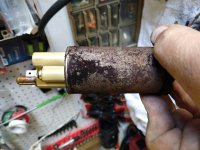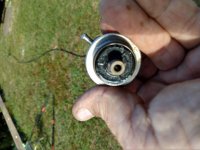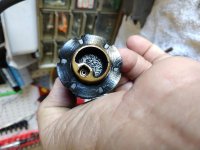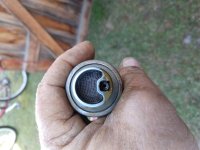

 This problem started a couple of years ago when I bought my first used 4 stroke with less than 300 hours on a rather old engine, but new to me. At first it started OK, and ran well, but would surprise me with starving for fuel, like it was sucking air, as it would if it was a 2 stroke. I changed ALL of the external fuel lines and bulb, the low and high pressure fuel filter, changed the plugs and added a fuel/water separator to the transom, installed a new low pressure fuel pump, and bought a manual for this model. Although rarely occurring, It still starved for fuel and would race at idle when I went from in gear to idle. I thought it was just a 4 stroke, and I would have to get used to it. This problem continued for the last couple of years, although very rarely. Finally I'd had enough. When It first started doing this, I attached a fuel pressure regulator to the schrader valve on the high pressure fuel tank, the VST, It was between 40 and 44 psi at idle, but erratic. I was OK with that then because I didn't know any better. This 4 stroke outboard stuff was still new to me. Last week, after a day on the lake, and running quite well but hard to start, it quit on me idling in a no wake zone approaching the boat ramp. I got it home and I was fed up. LOTS of reading later, I connected my fuel pressure gauge to the VST and the pressure was erratic but around 70 psi. I couldn't believe what I was seeing, but there it was. I knew the problem probably lied in the VST tank, and possibly the fuel pressure regulator, so this is my picture journey through the VST.
This problem started a couple of years ago when I bought my first used 4 stroke with less than 300 hours on a rather old engine, but new to me. At first it started OK, and ran well, but would surprise me with starving for fuel, like it was sucking air, as it would if it was a 2 stroke. I changed ALL of the external fuel lines and bulb, the low and high pressure fuel filter, changed the plugs and added a fuel/water separator to the transom, installed a new low pressure fuel pump, and bought a manual for this model. Although rarely occurring, It still starved for fuel and would race at idle when I went from in gear to idle. I thought it was just a 4 stroke, and I would have to get used to it. This problem continued for the last couple of years, although very rarely. Finally I'd had enough. When It first started doing this, I attached a fuel pressure regulator to the schrader valve on the high pressure fuel tank, the VST, It was between 40 and 44 psi at idle, but erratic. I was OK with that then because I didn't know any better. This 4 stroke outboard stuff was still new to me. Last week, after a day on the lake, and running quite well but hard to start, it quit on me idling in a no wake zone approaching the boat ramp. I got it home and I was fed up. LOTS of reading later, I connected my fuel pressure gauge to the VST and the pressure was erratic but around 70 psi. I couldn't believe what I was seeing, but there it was. I knew the problem probably lied in the VST tank, and possibly the fuel pressure regulator, so this is my picture journey through the VST.View attachment 19309
This is the bottom of the Walbro High Pressure Fuel Pump. It's rather easy to remove, and has a micro screen in the bottom, which was mostly clogged.
View attachment 19310
This is the clung on residue on the side of the pump. Lots of cleaning was ahead.
View attachment 19311
This is the bottom of the VST fuel pressure regulator. Yes, that is a clogged micro screen, so now I know where the ultra high pressures are coming from. The pressure regulator regulates the fuel pressure to 42 to 44 psi, and that center tube attaches to a tube in the upper VST which allows excess fuel to flow back into the lower VST storage reservoir, which the fluid level is controlled by float and needle, exactly like any float bowl on other engines. With the screen completely blocked, my high pressure fuel pump was allowing the full 70 psi to go to the injectors, or so it seems to me. Please correct me if this isn't the case. I figured I was very lucky not to clog or damage my injectors.
The screen on the pressure regulator was removable, so it was easy to clean. Be careful if you remove yours and take pictures, because it isn't the same on both sides, and it makes a difference when you reinstall it.
The screen on the HP fuel pump wasn't removable on the style I had, so I got a green scrubbing pad, cut it, and with a tiny screwdriver as a handle, I super cleaned it.
I also cleaned the tank and the pump itself before reassembly.
This job isn't a tough one. Anyone who has rebuilt carbs or low pressure fuel pumps will be comfortable with this. I replaced two small fuel hoses that attach to the black cooler on the side of VST, and replaced the clamps with stainless steel hose clamps.
I did one cautionary step when everything was reassembled. I pulled the high pressure fuel hose off where it attached to the black fuel cooler *the one that goes to the injectors* and ran it into a rather large mason jar. I then turned the key on several times and allowed the gas to flow into it so I could see what was still in it, and to get any debris that might still be in the VST out of there before it went to the injectors. You'd better be VERY comfortable working around gas if you choose to do this. DO NOT CRANK THE ENGINE OVER. JUST TURN THE KEY ON, LET THE HIGH PRESSURE PUMP CYCLE, AND TURN THE KEY OFF.
My engine runs like new now. I can't believe the difference cleaning the VST components made. My pressure of the VST sits on a steady 44 psi, and my motor hasn't run this smooth since I owned it.
I will add the VST cleaning to my maintenance when I do my water pump service. It's not difficult, but rather so important that you can't ignore it as a periodic maintenance item.
Good luck and Safe boating, my friends.

Last edited:

